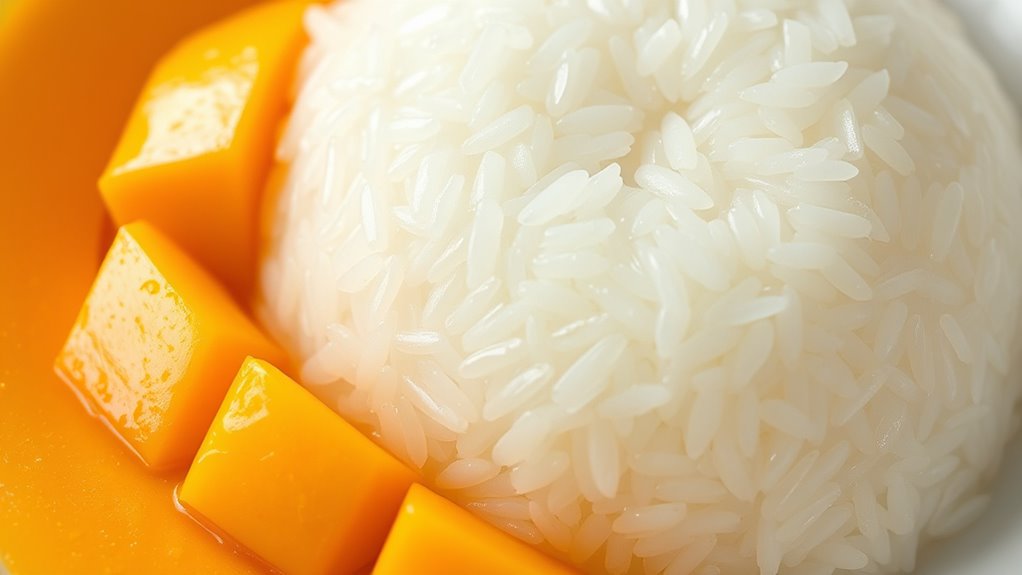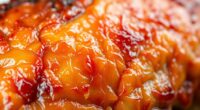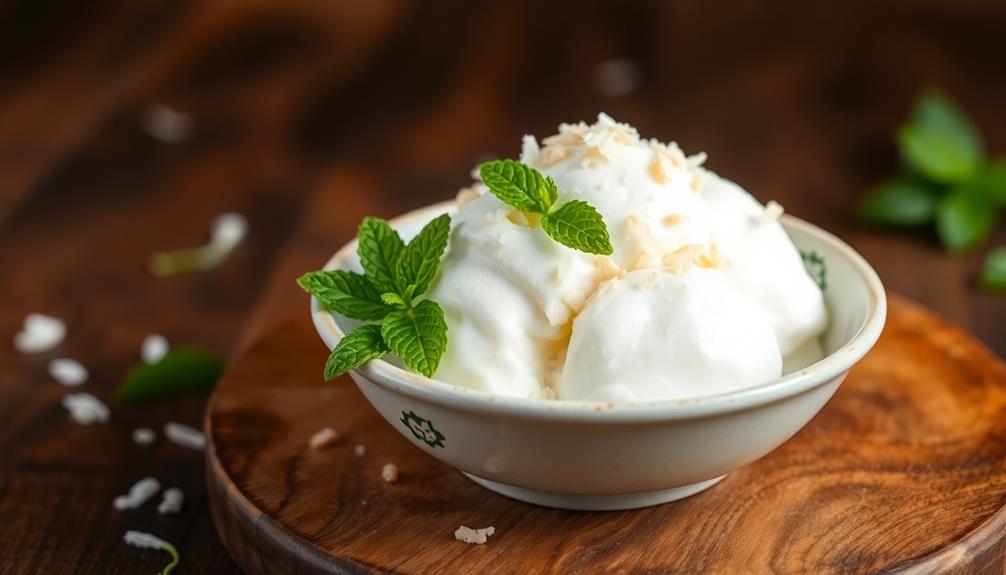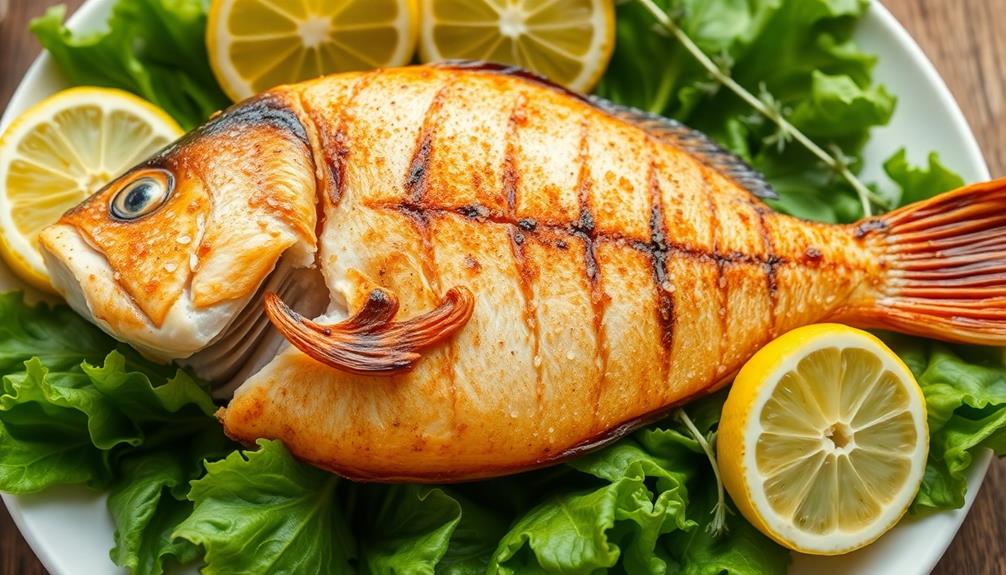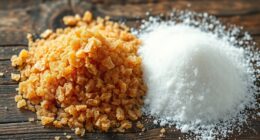To achieve the perfect mango sticky rice, focus on the amylopectin content in the rice. Amylopectin’s branched structure absorbs water rapidly during cooking, making the rice sticky and chewy. A high amylopectin ratio results in that ideal, cohesive texture you crave. Controlling cooking temperature and moisture helps activate this effect, preventing under- or over-gelatinization. Keep exploring to discover more tips on harnessing starch chemistry for flawless sticky rice.
Key Takeaways
- Amylopectin’s branched structure enhances water absorption during cooking, leading to optimal stickiness in mango sticky rice.
- A high amylopectin-to-amylose ratio ensures the rice remains chewy and cohesive after gelatinization.
- Proper gelatinization temperature and moisture levels activate amylopectin’s properties for ideal texture.
- Retrogradation causes rice to become firmer over time; controlling storage conditions maintains desired stickiness.
- Precise cooking techniques optimize amylopectin behavior, resulting in the perfect sticky, tender rice for mango pairing.
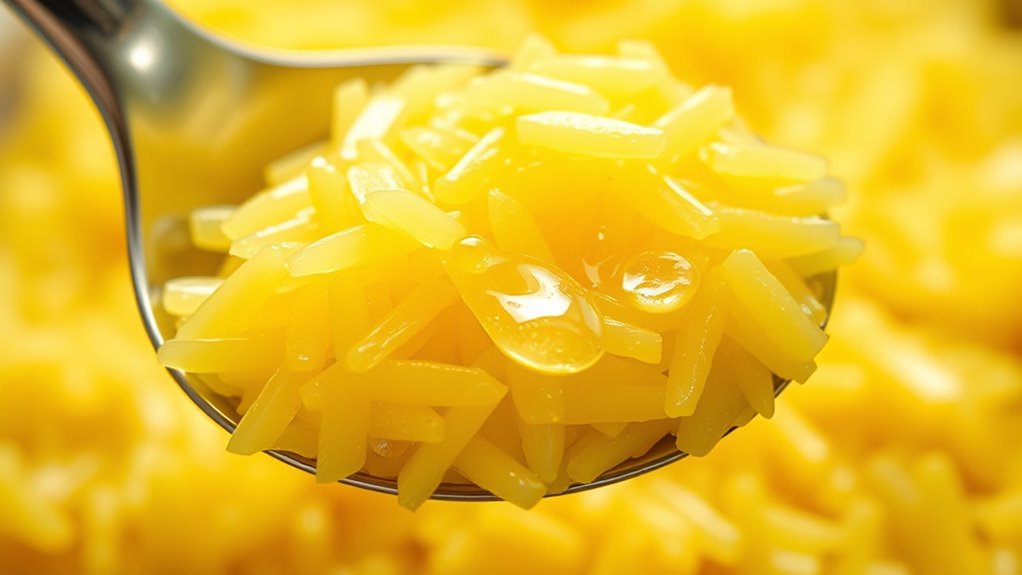
Mango sticky rice is a beloved Thai dessert that combines the natural sweetness of ripe mangoes with the chewy texture of glutinous rice. At the heart of its appealing texture lies a fascinating chemistry involving starches, particularly amylopectin, which influences both grain gelatinization and starch retrogradation. When you cook the rice, heat causes the starch granules inside to undergo gelatinization—a process where the heat and moisture cause the granules to swell, soften, and absorb water. This transformation is essential because it turns the rice from hard, individual grains into a cohesive, sticky mass. The high amylopectin content in glutinous rice plays a vital role here; its branched structure allows it to absorb water more rapidly and swell extensively during cooking, giving the rice its characteristic stickiness. The precise ratio of amylopectin to amylose significantly impacts the texture and quality of the cooked rice, determining how sticky or firm it becomes. Additionally, the presence of other minor components, such as lipids, can subtly influence the texture and flavor profile of the final dish.
Understanding the starch gelatinization process helps clarify why controlling temperature and moisture is crucial for achieving the perfect consistency. As the rice continues to cool after cooking, starch retrogradation begins. This process involves the reassociation of amylose and amylopectin molecules as they lose water and realign into more ordered structures. Retrogradation can cause the rice to become firmer or even develop a slight chewy texture over time. However, in the case of mango sticky rice, you want to strike a balance. Proper cooking guarantees that the rice remains tender and sticky without becoming overly hardened or dry. The degree of retrogradation depends on factors like storage temperature and time—if stored too long, the rice may become less desirable, with a less appealing texture. Controlling storage conditions can help maintain the ideal consistency and flavor.
Understanding the chemistry behind grain gelatinization and starch retrogradation helps you perfect the dish. When cooking the rice, controlling the temperature and moisture guarantees ideal gelatinization, resulting in grains that are soft, sticky, and plump. Using the right amount of water and cooking time prevents under- or over-gelatinization, which can lead to grains that are either too hard or too mushy. After cooking, if you plan to store the rice, keeping it at a warm temperature and consuming it relatively soon minimizes undesirable retrogradation. Conversely, slight cooling and refrigeration can sometimes enhance the flavor, but it also accelerates retrogradation, so reheating the rice properly is essential to regain its ideal texture.
A consistent cooking method is key to ensuring each batch has the same optimal texture. In essence, the magic of mango sticky rice hinges on mastering these starch processes. By understanding how amylopectin influences both gelatinization and retrogradation, you can guarantee each bite maintains the perfect balance of chewiness and moisture. The chemistry might be complex, but with precise control, you’ll consistently create a dessert that’s as satisfying to eat as it is fascinating to understand. Paying attention to the cooking process ensures the rice achieves the desired chewy yet tender consistency, making the dish irresistibly delicious.
Frequently Asked Questions
How Does Rice Variety Affect Mango Sticky Rice Texture?
You should consider how rice variety impacts mango sticky rice texture. Grain selection and cultivar differences play a vital role in achieving the perfect stickiness. Some rice cultivars have higher amylopectin content, making them stickier and more desirable for this dish. By choosing the right rice, you guarantee the rice clings well to the mango and coconut milk, creating that ideal chewy yet tender texture you’re aiming for.
Can Cooking Temperature Alter Amylopectin’s Role in Stickiness?
You might think that cooking temperature doesn’t matter, but it can really turn up the heat on amylopectin’s behavior. Temperature effects influence how amylopectin gelatinizes, directly impacting the stickiness of your rice. If you cook at too high or low temperatures, it can either make the rice too sticky or not sticky enough. So, adjusting your heat carefully guarantees the perfect balance, letting amylopectin do its job for that ideal chewy texture.
Does Mango Ripeness Influence the Rice’S Chemical Properties?
You might wonder if mango ripeness affects the rice’s chemical properties. As mango ripeness increases, it becomes sweeter and softer, but it doesn’t directly change the rice’s chemical makeup. However, the overall flavor and texture of your dish can be influenced, since ripe mangoes add more sugars and aroma. So, while ripeness impacts the fruit, it doesn’t markedly alter the rice’s chemical properties, just the overall sensory experience.
Are There Additives That Enhance Sticky Rice’S Amylopectin Structure?
You might wonder if rice additives can improve amylopectin structure in sticky rice. Yes, certain rice additives, like enzymes or specific starch modifications, can enhance amylopectin content and its arrangement. These additives work by breaking down or restructuring starch molecules, leading to better stickiness and texture. When used correctly, they optimize amylopectin’s role, giving you that perfect, cohesive consistency in your sticky rice.
How Does Storage Time Impact the Chemistry of Mango Sticky Rice?
You might notice that storage duration affects mango sticky rice’s texture and flavor over time. Longer storage can lead to fermentation effects, causing the rice to become more sour or mushy, and the mango to lose its freshness. To keep it ideal, consume it within a day or two. Proper refrigeration slows down these changes, preserving the rice’s stickiness and the mango’s sweetness, ensuring a delightful experience.
Conclusion
So, next time you indulge in mango sticky rice, remember it’s not just a sweet treat but a masterpiece of amylopectin chemistry. With the perfect balance of starch properties, your palate gets a luxurious, sticky experience—proof that even dessert has a degree in science. Who knew that mastering rice’s molecular secrets could elevate your snack game? Truly, science makes everything better—especially sticky rice, where amylopectin’s sticky finesse steals the show.
